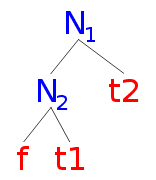One hole contexts or:
how I learned to stop worrying and love the zipper
Me



What's the Point?
- Share an interesting data structure
- Show some Scala code
What is a Zipper?
- Reification of a walk
- Derivative of a data structure
- A data structure with a hole
- Just something useful
Something Useful
Something Useful
- O(1) - In Place Update
- O(n)/O(log n) - Update
Something Useful
Example 1
Zipped List
case class ZippedList[T](before: List[T], focus: T, after: List[T]) { def goLeft(): ZippedList[T] = before match { case Nil => throw new Exception("Can't move left") case x::xs => ZippedList(xs,x,focus::after) } def goRight(): ZippedList[T] = after match { case Nil => throw new Exception("Can't move right") case x::xs => ZippedList(focus::before,x,xs) } def update(f: T => T): ZippedList[T] = ZippedList(before,f(focus),after) def zipUp(): List[T] = (focus :: before).reverse ++ after }
Form
Trees
abstract class BTree[A] case class Leaf[A](value: A) extends BTree[A] case class Node[A](value: A, left: BTree[A], right: BTree[A]) extends BTree[A]
Zipper
Simplify to Path, Focus
case class ZippedTree[T](path: List[Decision[BTree[T]]], focus: BTree[T])
Go Left
def goLeft() : ZippedTree[T] = focus match { case Leaf(_) => throw new Exception("Can't move left") case Node(_,l,_) => ZippedTree(Left(focus)::path,l) }
Defs
abstract class Decision[T] case class Left[T](value: T) extends Decision[T] case class Right[T](value: T) extends Decision[T]
Go Right
def goRight() : ZippedTree[T] = focus match { case Leaf(_) => throw new Exception("Can't move right") case Node(_,_,r) => ZippedTree(Right(focus)::path,r) }
Go Up
def goUp() : ZippedTree[T] = path match { case Nil => throw new Exception("Can't go up") case Left(Node(v,_,r)) :: rest => ZippedTree(rest,Node(v,focus,r)) case Right(Node(v,l,_)) :: rest => ZippedTree(rest,Node(v,l,focus)) }
Update
def update(f: BTree[T] => BTree[T]): ZippedTree[T] = ZippedTree(path,f(focus))
ZipUP
def zipUp(): BTree[T] = { def rollup(z: ZippedTree[T]): BTree[T] = z match { case ZippedTree(Nil,f) => f case x => rollup(x.goUp()) } rollup(this) }
Example
val t: BTree[Int] = Node(1, Node(7, Leaf(3), Leaf(4)), Node(7, Node(7, Leaf(9), Leaf(2)), Leaf(4)))
Example...

Live code...
<Insert bad demo here...>
What else can we Zip?
- N-ary Trees
- Streams
- ...any simple sum, product or recursive type
Maths interlude...
What are we doing?
Really all about creating paths to the current focus
Maths interlude...
Bit more formality
Path is a list of decisions, so let's annotate our decision and store the siblings of a node in the tree.
Maths interlude...

path to f is;
Left(N2) :: Left(N1)
Maths interlude...
Left(N2) :: Left(N1) + f => ZIPPER
Since we can recover the tree from the Zipper,
Left(N2) :: Left(N1) is the tree minus f,
the tree with a hole
One hole contexts
Left(N2) :: Left(N1)
That's a one hole context of BTree,
where BTree is a product type of Leaf | BTree*BTree
The notation * indicates a product type.
Think any tree with any other tree
You can do the same for ternary trees
Leaf | TTree*TTree*TTree
One hole contexts...
Each decision we make in a BTree has the type
Decision[Btree] which can be expressed
Left(BTree) | Right(BTree)
Which happens to be a sum type, BTree+BTree
Think all lefts and all rights
One hole contexts...
So a generous rewriting may give us,
BTree = 1 + BTree^2
TTree = 1 + TTree^3
∂BTree = 2BTree
∂TTree = 3TTree …
One hole contexts...
The derivative of a regular type is its type of one-hole contexts
So...?
In theory it is possible to synthesise a Zipper from any regular type, with arbitrary navigation and update.
So...?
In practise we need more type-level programing...
